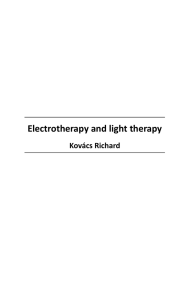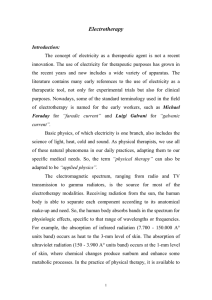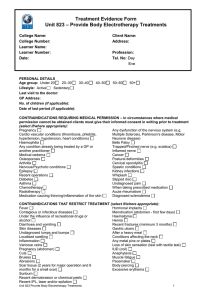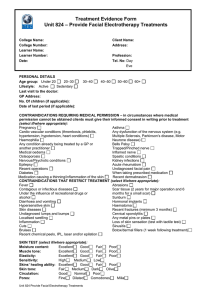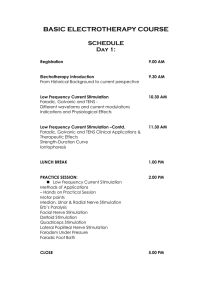Current concepts in electrotherapy
advertisement
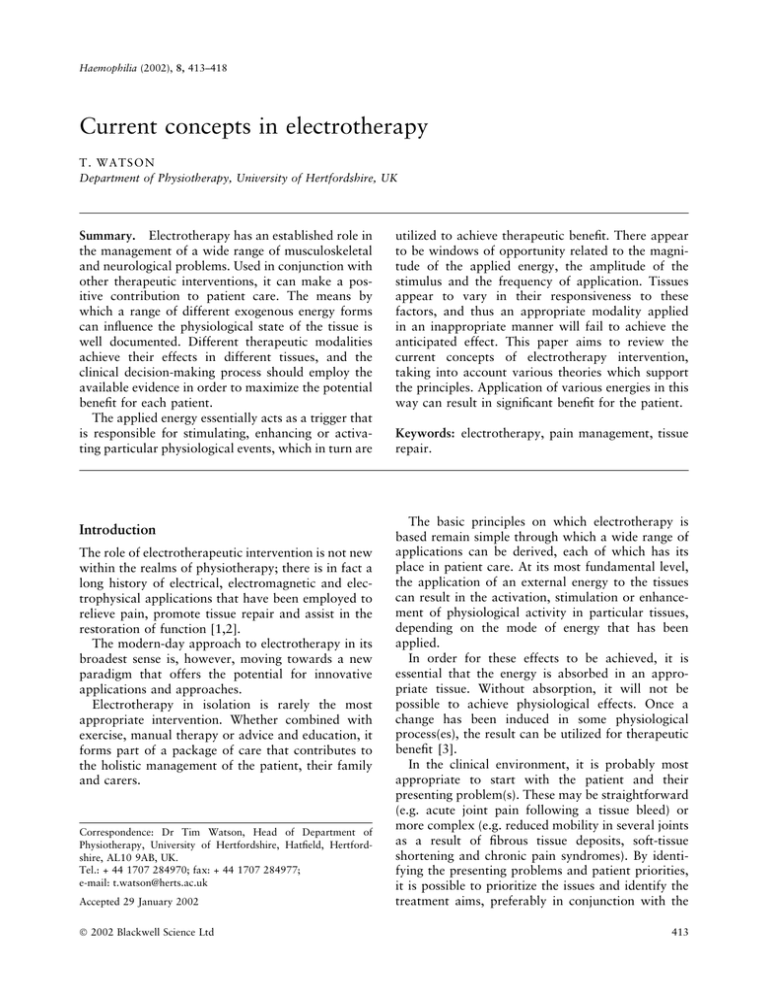
Haemophilia (2002), 8, 413–418 Current concepts in electrotherapy T. WATSON Department of Physiotherapy, University of Hertfordshire, UK Summary. Electrotherapy has an established role in the management of a wide range of musculoskeletal and neurological problems. Used in conjunction with other therapeutic interventions, it can make a positive contribution to patient care. The means by which a range of different exogenous energy forms can influence the physiological state of the tissue is well documented. Different therapeutic modalities achieve their effects in different tissues, and the clinical decision-making process should employ the available evidence in order to maximize the potential benefit for each patient. The applied energy essentially acts as a trigger that is responsible for stimulating, enhancing or activating particular physiological events, which in turn are Introduction The role of electrotherapeutic intervention is not new within the realms of physiotherapy; there is in fact a long history of electrical, electromagnetic and electrophysical applications that have been employed to relieve pain, promote tissue repair and assist in the restoration of function [1,2]. The modern-day approach to electrotherapy in its broadest sense is, however, moving towards a new paradigm that offers the potential for innovative applications and approaches. Electrotherapy in isolation is rarely the most appropriate intervention. Whether combined with exercise, manual therapy or advice and education, it forms part of a package of care that contributes to the holistic management of the patient, their family and carers. Correspondence: Dr Tim Watson, Head of Department of Physiotherapy, University of Hertfordshire, Hatfield, Hertfordshire, AL10 9AB, UK. Tel.: + 44 1707 284970; fax: + 44 1707 284977; e-mail: t.watson@herts.ac.uk Accepted 29 January 2002 Ó 2002 Blackwell Science Ltd utilized to achieve therapeutic benefit. There appear to be windows of opportunity related to the magnitude of the applied energy, the amplitude of the stimulus and the frequency of application. Tissues appear to vary in their responsiveness to these factors, and thus an appropriate modality applied in an inappropriate manner will fail to achieve the anticipated effect. This paper aims to review the current concepts of electrotherapy intervention, taking into account various theories which support the principles. Application of various energies in this way can result in significant benefit for the patient. Keywords: electrotherapy, pain management, tissue repair. The basic principles on which electrotherapy is based remain simple through which a wide range of applications can be derived, each of which has its place in patient care. At its most fundamental level, the application of an external energy to the tissues can result in the activation, stimulation or enhancement of physiological activity in particular tissues, depending on the mode of energy that has been applied. In order for these effects to be achieved, it is essential that the energy is absorbed in an appropriate tissue. Without absorption, it will not be possible to achieve physiological effects. Once a change has been induced in some physiological process(es), the result can be utilized for therapeutic benefit [3]. In the clinical environment, it is probably most appropriate to start with the patient and their presenting problem(s). These may be straightforward (e.g. acute joint pain following a tissue bleed) or more complex (e.g. reduced mobility in several joints as a result of fibrous tissue deposits, soft-tissue shortening and chronic pain syndromes). By identifying the presenting problems and patient priorities, it is possible to prioritize the issues and identify the treatment aims, preferably in conjunction with the 413 414 T. WATSON patient; there is little point is determining the patients’ problems without their agreement. Bioelectric cellular activity It is well established that all cells are electrically active, not just those of the ‘excitable’ tissues. The cell membrane has a membrane potential which averages some 70 mV, and this electrical cell membrane activity is critical to normal cell function [4]. The level of electrical activity of the cell membrane influences the general activity level of the cell. If the membrane is electrically quiescent, the cell downregulates, and its functional capacity diminishes. Conversely, with increased levels of electrical activity, upregulation occurs, and the general cell activity levels increase. By influencing the activity levels of the cell membrane, it is possible to adjust the ‘excitement’ level in the cell. This can be achieved with a variety of exogenous energy sources: electromagnetic (e.g. shortwave therapies, pulsed or continuous), electrical (e.g. transcutaneous electrical nerve stimulation; TENS) or electrophysical/mechanical (e.g. ultrasound) [3]. Each energy source is preferentially absorbed in different tissue types, hence, the physiological and therapeutic benefits are achieved in different tissues [3]. Ultrasound, for example, is preferentially absorbed in the dense collagen-based tissues [5] and will therefore achieve its best effects in tissues such as ligaments, tendons, fascia joint capsules and scar tissue. Electrical stimulation (such as TENS) will primarily affect the nerves, and electromagnetic radio frequency energy such as pulsed short-wave will be primarily absorbed in the wet, ionic tissues such as muscle, haematoma and oedematous tissue [6]. Modes of application There are two ways in which exogenous energy can be applied in order to achieve these changes. Both will affect the energy system of the cell, and both are applied in current practice. Higher energy therapies The first method is to deliver an energy form that will overcome the electrical activity of the cell membrane and thus force the cell to change its ‘excitement levels’ and hence its activity. Electrical stimulation in its various forms appears to work in this way. The electrical current passed through the tissues will cause the nerve membrane to depolarize and initiate a depolarization potential. Once the depolarization Haemophilia (2002), 8, 413–418 has been achieved (i.e. sufficient current is applied to achieve the threshold potential), an action potential is initiated and the nerve will conduct in a normal physiological manner. The electrical stimulation serves as the initiator (or trigger) of the action potential [2,7]. Stimulation of the sensory nerves can be utilized to achieve symptomatic pain relief by means of either the pain gate mechanism or by causing the release of endogenous opioids [7]. Motor nerve stimulation will result in some form of muscle contraction, the nature of which will depend on the frequency of the stimulus [2]. Different electrical stimulation modalities will achieve these effects in different ways, but they have a common mode of action. Interferential therapy, transcutaneous electrical nerve stimulation and faradic stimulation are all different forms of electrical stimulation. Although the machines used to produce each different type of electrical stimulus might be different, the principal effect on the nerve tissues is essentially the same. There are differences in the therapeutic effects achieved, as different current forms appear to have a differential effect on various types of nerve [2,8]. By deliberately selecting stimulation parameters that strongly influence sensory nerves for example, it is possible to stimulate normal physiological pathways which induce modulation at the sensory gating system in the dorsal horn of the spinal cord, and thus result in an adjustment of the neuromodulation state of the spinal gating mechanism [7]. By adjusting the stimulation parameters, different sensory nerves will be preferentially activated and this can result in increased endogenous opioid release in the cord [9]. Both forms of treatment can lead to symptomatic pain relief, but the physiological mechanism by which it is achieved is different, and can be applied under different circumstances in order to maximize the benefit for a variety of patients. Activation of the A-beta sensory fibres appears to be most efficiently achieved with electrical stimulation at frequencies in the range of 90–130 Hz. Activation of these fibres influences the pain-gate mechanisms at spinal cord level, serving to ‘shut the gate’ and hence reduce the patients perception of pain. The A-delta sensory fibres are most efficiently stimulated with much lower frequencies (in the 2–5 Hz range). The result of such activation induces the release of endogenous opioids in the cord and thus brings about pain relief by means of a different mechanism. The stimulator used to achieve these results appears to be less important than the frequency of the applied stimulation. Ó 2002 Blackwell Science Ltd CURRENT CONCEPTS IN ELECTROTHERAPY The commonality of electrical stimulation modes in use within physiotherapy is that the nerve is the target tissue. It is possible to employ alternative modes of current application in order to influence tissues other than the nerves. For example, small DC currents can be utilized to influence the healing responses of the musculoskeletal tissues [10] and interferential therapy has been employed to enhance fracture healing [11]. Low-energy therapies A second approach to exogenous energy application involves the use of much lower energy levels. Examples of these modalities include low-intensity laser therapy, in which the power output of the light is in the range of a few milliwatts rather than the magnitude of surgical and other destructive lasers. Therapeutic ultrasound will typically deliver a power output of less than 1 W cm–2. This energy is therefore delivered at levels which are insufficient to bring about significant heating of the tissues. The effects are essentially ‘non-thermal’, although there must be a thermal component with any energy absorption. The intention with modalities such as laser therapy, pulsed short-wave therapy and ultrasound is to bring about an increase in cell membrane activity (usually by influencing a variety of ion gates or channels), and by doing so, to bring about a change in cell state without overt heating effects [3,12]. Maxwell considered the effects of therapeutic ultrasound at cellular and subcellular levels, raising several interesting points with regard to possible tissue effects of the intervention [13]. Examples of clinical applications that have demonstrated significant benefit include tendons [14], and a range of other musculoskeletal tissues [15]. It has been demonstrated that ‘non-thermal’ effects can strongly influence the tissues, inducing significant changes in tissue activity [16]. By utilizing the energy mode that is preferentially absorbed in the target tissues it is possible to trigger a range of physiological changes that can be subsequently employed to achieve therapeutic benefit. Windows of opportunity Given the wide range of electrotherapies currently being applied in clinical practice, it is important to consider their mode of action, the tissues that are preferentially targeted and the energy levels required in order to best achieve these effects. There is a substantial evidence base to support the application of these therapies in a variety of pathologies, yet not in others. Ó 2002 Blackwell Science Ltd 415 If the energy is delivered at the appropriate level, a significant effect can be achieved. If too little energy is applied, the trigger will be insufficient to bring about the desired effect. If too much energy is applied, however, it appears that the tissues will be overloaded, and the desired effect will not be achieved [17]. The concept of energy windows is gaining credibility, and alongside this, there also appear to be amplitude windows and frequency windows [18–21]. If it can be imagined that any particular tissue in a normal or pathological state is susceptible to some form of energy, provided it is delivered in sufficient quantity with an appropriate frequency and amplitude, it is easy to imagine how electrotherapy applications can achieve significant results. If the modality is delivered at an inappropriate energy level and/or frequency and/or amplitude, it is clear that there are many different ways in which the potentially appropriate modality can fail to achieve the desired result [3]. Work is currently in hand that aims to utilize the available evidence to determine the scope and position of the energy, frequency and amplitude windows, thereby increasing the likelihood of delivering the most effective modality at the most appropriate dose for the desired outcome. There exists substantial evidence in relation to electrotherapeutic modalities. Not all the evidence is supportive of these applications. Rather than considering these to be ‘negative’ publications, one could consider that these publications are positive in that they are assisting in establishing the position and magnitude of these windows of opportunity, and hence refining the clinical decision-making process, improving the quality of patient care and minimizing wasted interventions. There is no ‘magic’ to the application of electrotherapy in the clinical environment. There is no one single modality that will achieve the best results under all circumstances. The plethora of different machines can be reduced to a limited number of energy types. Each energy mode will have applications for which it is more effective and others for which it is less so. This principle also holds true for other therapeutic interventions, whether manual therapy to increase mobility in a soft tissue, or a particular form of analgesic medication for pain relief. Patient responsiveness One of the factors which causes difficulties in both electrotherapy research and in clinical practice is the fact that patients with apparently identical Haemophilia (2002), 8, 413–418 416 T. WATSON conditions will respond differently to identical treatments. As previously, this is not unique to the application of electrotherapeutic modalities. Other forms of physical therapy generate similar results; a particular form of manual therapy may achieve exceptional results in one patient, yet that same treatment, delivered by the same therapist, may achieve little benefit in another patient with an apparently identical problem. Similarly, many forms of drug therapy cannot be assured to bring about an identical result in all patients. It is of interest to speculate as to why some patients respond so positively, while others derive little or no beneficial effect. If it were possible to pre-screen the patients into groups, such that the membership of a particular group would enable the therapist to predict whether a positive or zero outcome effect was most likely, the efficacy of such interventions would be significantly improved. In order to be able to achieve this screening, it is essential to understand why it is that patients respond in such different ways. Given the present levels of knowledge, it is not possible to predict the treatment outcomes with accuracy. Laboratory and clinical evidence can certainly assist in predicting which mode of intervention is more or less likely to gain the optimal results. Knowing that treatment A is more likely to be effective than treatment B is a useful baseline from which to make a judgement, but further refinement of the clinical decision-making model will only be achieved with the publication of additional clinical outcome trials. At some point in the future, it may be possible to suggest with some accuracy that a younger patient with a haemarthrosis will respond preferentially to, say, active exercise and ultrasound while an older patient with a similar problem, may respond preferentially to the application of pulsed short-wave therapy. This assumes of course that age is a primary factory in considering outcome in patients treated with an acute haemarthrosis. It may be that the critical parameter is not age, but sex or height or weight or lean body mass. Given the number of potentially important variables, it less than surprising that full documentation of the permutations has yet to be achieved. One area that offers potential for differentiating between patients in this way relates to their endogenous bioelectric activity. All musculoskeletal tissues are electrically active and the magnitude of this activity varies between individuals [22]. All ‘normal’ individuals appear to present with a common pattern of electrical activity, whether one is considering the electrical potentials of the skin or those of the tibia. Haemophilia (2002), 8, 413–418 Although the pattern of electrical activity may be the same, the magnitude can vary considerably between individuals [23]. By measuring the magnitude or pattern of the naturally produced electrical signals derived from such tissues, it may be possible to infer the patients potential responsiveness to a particular form of therapy. Far from being a hypothetical concept, several researchers have been investigating these principles with some success Although at the present time it is not possible to make such definitive statements with regard to predicted outcome, it may well become one of the tools by which such judgements will be made in the future [22]. Special client groups and electrotherapy A brief mention should be made in relation to particular circumstances that affect haemophilia patients with respect to electrotherapy. Firstly, the issue of application of electrotherapy modalities to children. It is difficult to find detailed documentation in this respect, but it is a widely held consensus view of experts in the field that it is acceptable to treat children with electrotherapy modalities, with the general exception of the active epiphyseal regions. The problem here is that the external energy may adversely influence the active region, although there is no specific evidence to show that this is the case. A second circumstance that is generally held as a contraindication for electrotherapy modalities is tissue where bleeding is active or where there is the possibility of tissue bleeding. The risk here is that most electrotherapy interventions appear to cause an increase in local blood flow, and to do this in tissues that are bleeding could clearly have an adverse effect. Given that both of these circumstances could reasonably be expected to come into play in the management of haemophilia patients, especially in the immediate postbleed treatment phase, there is a need for further controlled trials to determine the magnitude of the ‘adverse effects’ and the relative risk. In the absence of such data, it is the view of experts in the field that electrotherapy can be applied to patients who have haemophilia, so long as they are covered by the appropriate factor replacements thus dealing with the ‘tissue bleed’ scenario. When it comes to the treatment of children who have experienced a haemarthrosis, for example, it is a matter of relative risk. There is a theoretical (but unproven) risk that electrotherapy intervention may adversely affect the active epiphyseal region, yet at the same time, there is a risk associated with not Ó 2002 Blackwell Science Ltd CURRENT CONCEPTS IN ELECTROTHERAPY actively treating the haemarthrosis condition as soon as possible postbleed. In the absence of any more detailed data at the present time, it is suggested that it could be considered appropriate to use electrotherapy intervention postbleed in children (e.g. pulsed short-wave for acute knee or ankle haemarthrosis), on the basis that the relative risk of the adverse effects of the intervention are less problematical than the relative risk of not treating the problem (i.e. long-term joint dysfunction). It is considered important to conduct controlled trials for electrotherapeutic intervention in these patient groups in order to establish the benefits of the therapy, thus enabling the risk/benefit analysis to be considerably more accurate. Future developments New electrotherapy modalities are introduced into the clinical environment with alarming regularity. They are often not fully evidenced in terms of their mode of action, nor their physiological and/or therapeutic effectiveness. Laboratory and clinical trials are essential in order to evaluate these interventions before widespread application is appropriate. By evaluating the form of energy being delivered to the patient, it is possible to predict their preferential target tissue, and hence, their most potentially effective application areas. Most (if not all) new therapies are in fact a variation on a theme of an existing modality. By refining the waveform, signal amplitude, pulse frequency or other salient feature of the energy form, these new therapies offer the potential to improve the effectiveness of the treatment. Conclusions Assuming that the basic tenets of modern electrotherapy are essentially correct (supported by the evidence), then the potential value for a continued use of electrotherapy within the realm of modern physical therapy practice is significant. Like any therapy, its value needs to be established, the process of clinical decision-making needs to be refined and the inappropriate forms of electrotherapy, or those that are less effective, need to be replaced by those for which there is substantive, documented evidence of efficacy. As a mode of intervention, like any other, there are patients who respond well to treatment and others who do not. By evaluating the substantial evidence base, further refinements to modern treatment programmes should be achieved. Ó 2002 Blackwell Science Ltd 417 An electrotherapy modality applied in the most appropriate circumstances should be able to achieve significant benefit. Applied at a less than fully appropriate energy level, amplitude or frequency, it is likely to ‘miss the mark’ and a less beneficial outcome may result. Further refinement of the treatment paradigms is essential, but given the knowledge and evidence base to date, quality intervention is already possible. The more evidence that is generated, the more refined the decision-making process will become. As one part of the therapeutic armoury, electrotherapy has a well earned place in the modern management of patient problems. Its use in combination with other forms of physical therapy, e.g. manual therapy, exercise therapy, postural correction and patient education, is likely to achieve the most significant results. Used inappropriately, it is at best ineffective. Using the evidence base to enable quality decision-making and treatment is the route by which the efficacy of this type of intervention will be improved. References 1 Kitchen S, Bazin S, eds. Clayton’s Electrotherapy, 10th edn. Philadelphia: WB Saunders, 1996. 2 Low J, Reed A. Electrotherapy Explained: Principles and Practice, 3rd edn. Oxford: Butterworth Heinemann, 2000. 3 Watson T. The role of electrotherapy in contemporary physiotherapy practice. Man Ther 2000; 5: 132–41. 4 Charman RA. Bioelectricity and electrotherapy – towards a new paradigm: Part 1. The electric cell. Physiotherapy 1990; 76: 503–8. 5 Frizzell LA, Dunn F. Biophysics of ultrasound. In: Lehmann, J, ed. Therapeutic Heat and Cold, 3rd edn. Baltimore: Williams & Wilkins, 1982. 6 Ward AR. Electricity, Fields and Waves in Therapy. Marrickville, Australia: Science Press, 1980. 7 Walsh D. TENS. Clinical Applications and Related Theory Edinburgh: Churchill Livingstone, 1997. 8 Savage B. Interferential Therapy London: Faber & Faber, 1984. 9 Han JS, Chen XH, Sun SL et al. Effect of low- and high-frequency TENS on Met-enkephalin-Arg-Phe and dynorphin A immunoreactivity in human lumbar CSF. Pain 1991; 47: 295–8. 10 Watson T. Electrical stimulation for wound healing. Phys Ther Rev 1996; 1: 89–103. 11 Ganne J-M. Stimulation of bone healing with interferential therapy. Aust J Physiotherapy 1988; 34: 9–20. 12 Mortimer AJ, Dyson M. The effect of therapeutic ultrasound on calcium uptake in fibroblasts. Ultrasound Med Biol 1988; 14: 499–506. Haemophilia (2002), 8, 413–418 418 T. WATSON 13 Maxwell L. Therapeutic ultrasound. Its effects on the cellular and molecular mechanisms of inflammation and repair. Physiotherapy 1992; 78: 421–6. 14 Enwemeka CS, Rodriguez O, Mendosa S. The miomechanical effects of low intensity ultrasound on healing tendons. Ultrasound Med Biol 1990; 16: 801–7. 15 McDiarmid T, Burns PN. Clinical applications of therapeutic ultrasound. Physiotherapy 1987; 73: 155–62. 16 Frohlich H. What are non-thermal electrical biological effects? Bioelectromagnetics 1982; 3: 45–6. 17 Karu T. The Science of Low-Power Laser Therapy Amsterdam: Gordon & Breach, 1998. 18 Litovitz TA, Montrose CJ, Goodman R et al. Amplitude windows and transiently augmented transcription Haemophilia (2002), 8, 413–418 19 20 21 22 23 from exposure to electromagnetic fields. Bioelectromagnetics 1990; 11: 297–312. Goldman R, Pollack S. Electric fields and proliferation in a chronic wound model. Bioelectromagnetics 1996; 17: 450–7. Karu T. Photobiological fundamentals of low power laser therapy. IEEE J Quant Electronics 1987; QE23: 1703–17. Cleary SF. Cellular effects of electromagnetic radiation. IEEE Engng Med Biol 1987; 6: 26–30. Watson T. Bioelectric Correlates of Musculoskeletal Injury and Repair. PhD Thesis. Guildford, Surrey: Department of Mechanical Engineering, 1995. Becker RO. Cross Currents, 1st edn. London: Bloomsbury, 1990. Ó 2002 Blackwell Science Ltd
